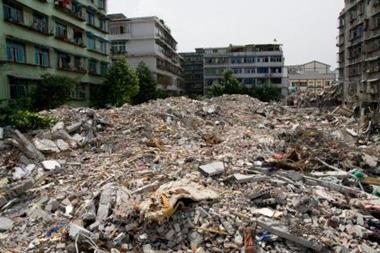Despite recent disasters, some businesses are still not prioritising effective continuity plans for when the worst happens. But can excessive damage be avoided as brokers begin to favour a real disaster recovery service rather than get-out-quick cash settlements?
Trees were ripped from their roots, power lines fell, waves reached 15ft and nearly 20,000 homes were starved of electricity as Hurricane Igor pounded Bermuda, the home of the world’s biggest offshore insurance market.
But tracing every 93mph gust on their monitors was the claims team of XL?Insurance – 15 people scattered between Zurich, the UK and the USA. Satellite mapping helps the team predict the likely damage to every single home and business on the tiny island. This highly sophisticated set-up meant that XL could inform insurers exactly what damage they could be liable for when Igor vented its fury last month.
XL’s satellite mapping system is just one example of how the insurance industry is prepared like never before to help businesses and, to a lesser extent, individuals recover from the impact of disasters, be they natural or man-made.
A series of hugely damaging disasters, including the UK’s flash floods of summer 2007, which cost the industry £3bn, has forced insurers to improve their services to customers in a bid to mitigate their own costs, particularly as businesses themselves rarely have suitable contingency plans in the event of a storm, flood or fire.
XL’s head of property claims, Paul Slaven, is proud of his team’s technologically advanced operation. “We now get people onsite within hours,” he explains. “There are even situations where the insurer hasn’t notified us about the damage, and we’ve been able to notify them. You need to get the right people to the right areas quickly to reduce loss. For example, we can get machines out of flood waters quickly and clean them, whereas 15 years ago they would have been left there for a couple of weeks and would have had to be replaced.”
In November last year, floods reaching 2.5 metres caused £100m of damage in small towns across Cumbria. But this cost would have been far higher if not for the efforts of teams like Slaven’s to put flood dispersal pattern forecasts over street maps to pinpoint the most endangered areas. So specific was the data that flooding at individual warehouses could be identified and defences could be put in place.
Slaven admits that this method is much simpler for commercial insurance than personal, as getting your people to hundreds of individual houses is obviously a much more intensive operation. But protecting businesses rather than just paying out cash settlements helps local economies and employment, as fewer companies will have to stop trading, even temporarily.
Where’s your contingency?
And businesses need help. Biba research at the end of last year showed that 45% of companies had either no or only very rough plans drawn up for continuing to trade after a disaster, while 80% were not prepared for a repeat of an event of the scale of the 2007 floods.
Less than 15% were even aware of BS 25999, the British Standards Institution’s certificate awarded to businesses with well drawn-up contingency proposals.
Biba technical and corporate affairs executive Graeme Trudgill says that businesses are “very vulnerable if there is another Buncefield disaster”, referring to the oil storage depot that exploded, injuring 40 people, in Hertfordshire in the early hours of 11 December 2005. It is generally accepted that 60%-70% of businesses affected by Buncefield have gone bust.
Trudgill says that most customers think that having 12 months’ business interruption insurance in the event of a fire will be sufficient to make up the losses. However, if, for example, an accounts department is flooded, invoices cannot be sent out, creating a backlog that could take 18 months or more.
“They must have an IT back-up solution,” he argues. “It’s simple to set up a laptop link so that you don’t lose all that data.”
He adds that brokers have become more involved in helping businesses with their post-disaster recovery plans since the 2007 floods. “We see brokers that even include the term ‘risk management’ in their titles now,” says Trudgill, who explains that helping businesses with their continuity plans means that brokers that provide this service will be judged on quality of advice rather than merely cost, thus helping them to win more work.
“You’re not competing on the products offered, so a broker up the road offering something that is 10% cheaper will not automatically get the customer.”
Doesn’t have to cost the earth
THB UK chief executive Andy Hawkes says that Biba has worked hard to persuade the industry that they can win work by focusing on disaster recovery advice.
THB advises small businesses to use the wide array of inexpensive or even free software that has emerged in recent years to draw up their continuity plans. These applications have been developed by IT companies that have spotted an enormous gap in the market following infamous disasters like Hurricane Katriona.
One example is Global Continuity’s business assist product, which within one working day of a disaster denying a business access to its premises can provide laptops and switch telephone lines from the office to people’s homes. This can cost as little as £250 a year.
“At least with this you then have something to get you going,” Hawkes says. “It used to cost £20,000, £30,000 or even £40,000-plus to have such plans in place – now it’s only several hundreds or in the early thousands. The client will be glad to be back in business and the insurer will be happy [to pay out less in business interruption cover].”
Flood and fire restoration group Belfor UK’s managing director, Neil Courtney, says the bigger national brokers have always been well versed in providing disaster recovery advice. “But that has now filtered through to more regional, specialist brokers. Awareness has definitely increased.”
Some of the best advice involves warning small businesses that huge disruptions to the supply chain involve a tremendous amount of administration, such as cancelling orders. Brokers are now walking businesses through ways of minimising such time-consuming problems.
Get in the experts
Meanwhile, insurers’ supply chains have become more sophisticated since the industry struggled to cope with the 185,000 claims that emerged as a result of the 2007 floods. Kent-based disaster restoration group Davies Recovery director Brad Wilby says that the number of poorly resolved claims has meant that insurers now only hire the most suitable companies to salvage property.
“Previously, Joe Bloggs Builders would buy a dehumidifier and, guess what?” sighs Wilby, without allowing time for an answer. “They’re not drying and restoration specialists. After the 2007 Hull floods, a lot of insurance clients realised the true value of a specialist rather than just hiring a builder. The disaster restoration business is evolving so quickly. Clients are so much more demanding. In the last 18 months, they now literally want a one-stop shop.”
In other words, he argues, insurers want big specialist restorers to recover an entire property, rather than get a number of small builders to repair certain aspects, from facades to water-damaged IT rooms. Once the industry had looked at the extraordinary cost and complications resulting from the floods, they realised that big specialists could act more quickly, comprehensively and accurately. And, as a result, the outcome was cheaper than if a number of poorly qualified alternatives had been used, Wilby says.
Belfor’s Courtney agrees, pointing out that insurers now even want restoration firms that have a global reach, so that they can support insurers on storms and floods that harm a number of countries or provide them with a broad, more cost-effective long-term contract.
British Damage Management Association (BDMA) director Jonathan Davison agrees that the supply chain’s needs have “moved towards the bigger players with national coverage”, which means that insurers are now “very well prepared for surge events” like severe weather disasters. He adds that cash settlements are becoming less in vogue, with insurers increasingly willing to get restorers onsite rather than just pay out to get the liability off their books.
“Cash settlements, even though they are still an important part of the solution, have become far less of a percentage of the claims in total,” Davison says. “Insurers have developed a more sophisticated supply chain model after seeing how much they have spent [just settling] over the years. This has left a more efficient approach, where they work together to drive down costs as well as provide a greater duty of care to their policyholders.”
Davison points to Sir Michael Pitt’s review of the 2007 floods, which showed that those insurers that made detailed risk assessments of the potential for such an event saved millions of pounds in payouts. Insurers took note, resulting in initiatives like the heavy data analysis carried out by the XL team.
The BDMA, which has worked with the ABI’s property committee on disaster recovery, is still critical of what it calls the lack of a “common approach”. This really applies to the impact on the individual rather than businesses. With so many dwellings and different insurers involved, people’s properties were restored at varying paces.
“If you went down to Hull after 2007, for example, you could walk down a street with almost identical properties, some of which were stripped out, others taking 18 months to dry, and some people just leaving them,” Davison says. “That’s not acceptable really. The industry needs a standard that produces a common approach to resolve these issues.”
Look in the mirror
But it’s not just clients that can remain unprepared for potential disasters; the mega-insurers based in major urban areas like London or Manchester are not as well prepared for potential disasters as their counterparts in banking, according to Jon Finn, chief operating officer at Wildnet, which provides technology and IT expertise to the insurance industry.
Finn joined from Morgan Stanley in January and says that insurance is behind investment banking in its own disaster recovery, though there is “a definite trend to taking it more seriously”.
The big investment banks have much of their IT infrastructure hosted offsite, so that they have all the necessary data to start again should a fire wreck their headquarters. That industry is naturally ahead of insurance because of the reliance on IT as paper-based trading came to an end.
“It is not ideal to host IT infrastructure within any organisation’s HQ,” Finn argues. “They should be aiming to locate that critical infrastructure offsite, and across two sites for resilience.”
So while the insurance industry may have wonderful technologies to scan the progress of great hurricanes and tropical events, perhaps it should take a closer look at protecting itself against disaster. In the meantime, efforts to get onsite and mitigate the effects of business interruption for their clients will keep local economies going through difficult times, and is likely to bring in more work in the future. IT
Be there on day one
Chartered Institute of Loss Adjusters (CILA) executive director Malcolm Hyde went to Cockermouth in the wake of last November's devastating floods. He was there to hold public meetings with local businesses soon after the floods struck, in order to ensure that they fully understood their policies.
What Hyde found was that many smaller businesses seriously misunderstood their policies. For example, an IT company with a £50,000-a-year turnover that found its premises damaged refused to trade elsewhere while the office was being restored; they believed that earning £20,000 elsewhere would put the whole £50,000 cover in jeopardy.
Hyde had to explain that the remaining £30,000 would still be covered. More importantly, by getting a broker to help them continue to trade, that business would not lose long-term custom and suppliers to rivals.
"On day one of a fire or loss, anything we can do to mitigate that loss also benefits the policyholder," Hyde says. "Every 50p in the pound saved by continued trading saves the insurer money, so we can't get businesses more indemnity but we can help them continue to work with their customers and suppliers.
"You have to help them through the initial stage of shock following a disaster. When an expert [such as a loss adjuster] comes along, a lot of people's first thought is that they're there to try to cut down their settlement."





































No comments yet